《英语》(基础模块)(修订版)第二册第一单元
- 格式:docx
- 大小:238.99 KB
- 文档页数:21


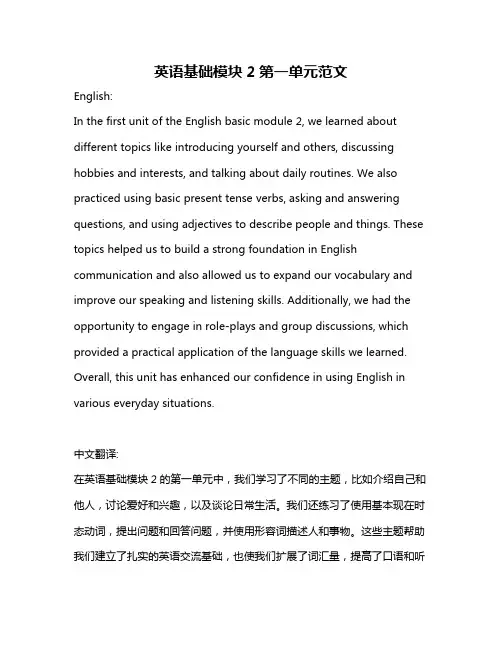
英语基础模块2第一单元范文English:In the first unit of the English basic module 2, we learned about different topics like introducing yourself and others, discussing hobbies and interests, and talking about daily routines. We also practiced using basic present tense verbs, asking and answering questions, and using adjectives to describe people and things. These topics helped us to build a strong foundation in English communication and also allowed us to expand our vocabulary and improve our speaking and listening skills. Additionally, we had the opportunity to engage in role-plays and group discussions, which provided a practical application of the language skills we learned. Overall, this unit has enhanced our confidence in using English in various everyday situations.中文翻译:在英语基础模块2的第一单元中,我们学习了不同的主题,比如介绍自己和他人,讨论爱好和兴趣,以及谈论日常生活。
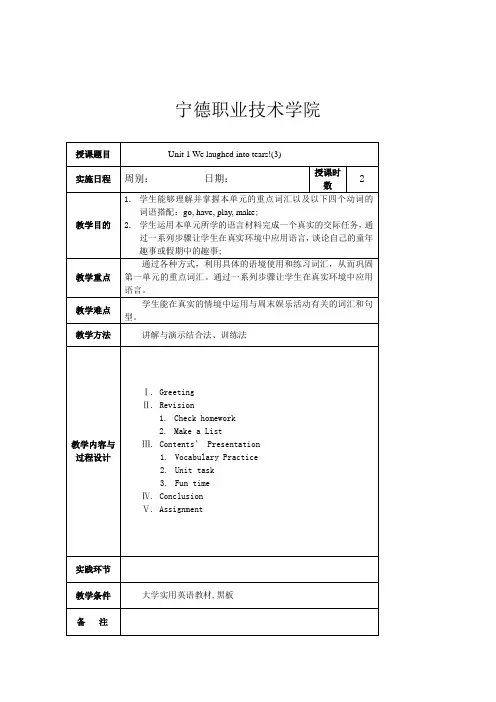
宁德职业技术学院教学过程与内容:Ⅰ. GreetingⅡ. Revision1. Collect the Ss’ homework and get some of them to tell others key phrases of what they will talk today. Get others to guess.S1(Li Jie): went swimming bathed in the sun walked along the beachT: What did Li Jie do last vacation?S2: She went swimming, bathed in the sun and walked along the beach.T: Where did she go?S3 to S1: Did you go to Sanya?S1: No, I didn’t.S4 to S1: Did you go to Qingdao?S1: No, I didn’t. I went to Thailand.T: Who did she go with?S5 to S1: Did you go with your parents?S1: Yes, I did.(设计意图:这一步骤教师既能对学生的作业情况进行及时地检查,教师在并听的过程中边提出问题,并且问题是结合上一课时的知识点,又可以检查学生们对于一般过去时的掌握情况。
教师让说的学生故弄玄虚,不把完整的信息全部告诉大家,更增添了其他同学的好奇心,鼓励学生用上一课时学过的句型进行提问和回答。
教师因此也达到了复习一般过去时的目的。
同时,教师也为下一班即将要进行的表演做了铺垫。
)2. Present the phrases the Ss mentioned and make a list, omitting the verbs.(设计意图:教师把学生所说到的短语,列在一张表格中,把动词省略掉。


《英语》(基础模块)(修订版)第二册第一单元-CAL-FENGHAI.-(YICAI)-Company One1外研版基础模块(修订版)第二册Unit 1 Nice to meet you! 一、单元整体解读及分析二、分课时教学设计第一课时时间环节意图3’导入一、师生互动二、教师随机提问:Who was the first one yougreet in the school this morningWhat did you say教师把回答板书在黑板上。
集体回答。
个别回答。
拉近师生距离,迅速进入主题。
38’听说练习Pre-listening:1)头脑风暴:We have met many familiars. NowI will introduce a new comer David toyou. Let’s say something tohim.教师展示图片。
并把学生的回答写在黑板上。
注意书写位置要便于下一环节的归类。
已有的内容直接在板书上划出来。
2)角色扮演:教师请学生两人一组,借鉴板书上的句型,完成和David的对话。
教师把学生使用的新句型写在黑板上。
学生举手回答。
学生准备两分钟后和搭档们进行对话,教师将选择其中三组上台作“角色扮演”。
“头脑风暴”的意图有两个:一是为了让学生联想起大脑中已储存的“寒暄”句型。
为下一步的听力作准备。
二是为活动③Listenagain and act中的句型拓展作铺垫。
“角色扮演”的意图有两个:一是通过对话对听力材料进行预设,降低学生对听力练习的焦虑。
二是拓展句型,丰富活动③Listen againand act环节学生输出时的语While-listening:1)“拼图”①播放录音第一遍Tell me what you hear in the dialogue. Any word, phrase, or sentence is good.教师把学生回答的内容写在黑板上,板书时要注意有意识地按照课文顺序进行书写。


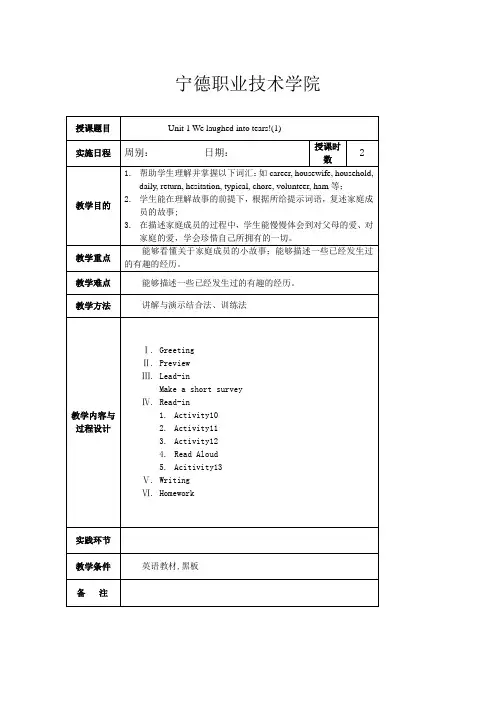
宁德职业技术学院教学过程与内容:Ⅰ. GreetingⅡ. Preview本单元是学生第二学期的第一单元,话题与学生的假期活动相关。
而学生刚从假期中归来,仍沉浸在假期的快乐中。
第一单元的话题非常符合学生的兴趣和当时的心情,这为本单元的学习打下了良好的基础。
第一单元的教学内容主要为:能够听懂并谈论假期中的活动;能够看懂关于家庭成员的小故事;能够描述一些已经发生过的有趣的经历;能够掌握并运用一般过去时的肯定式和否定式;能够在朗读时注意句子中的重读音节。
本单元的话题虽然亲切,教师仍然要注意运用多种教学手段,并关注每一个学生,在一些教学步骤中采用分层设计,帮助学生达成教学目标。
Ⅲ. Lead In(设计意图:把活动9的问题进行补充,多方面的问题能够让学生慢慢回忆起家庭中的各种趣事,从而会在下面的阅读中引起共鸣。
可以叫几个学生做一个简短的汇报,必定会引起其他同学的笑声不断。
本课时的教学即能在欢快轻松的氛围中展开。
)Ⅳ. Read-in1. Activity 10: fast reading. Get the Ss to read the letters as quickly as they can and tick the right topic. Then check the answer with the whole class.(设计意图,这一教学活动要求学生抓住重点,培养他们快速捕捉信息的能力。
)2. Activity 11. Read the letter again and tick the things Bob’s mother and Ben’s father did.(设计意图,找出课文中的关键活动,初步理解课文。
)3. Activity 12. Read the letters again and tick the correct sentences. Then check the answers with the Ss. See if they have any problems, help them with some important and difficult points.(设计意图,通过找出正确的句子让学生进一步理解课文,同时在与学生校对答案时看他们是否存在阅读障碍,讲解重点词组。
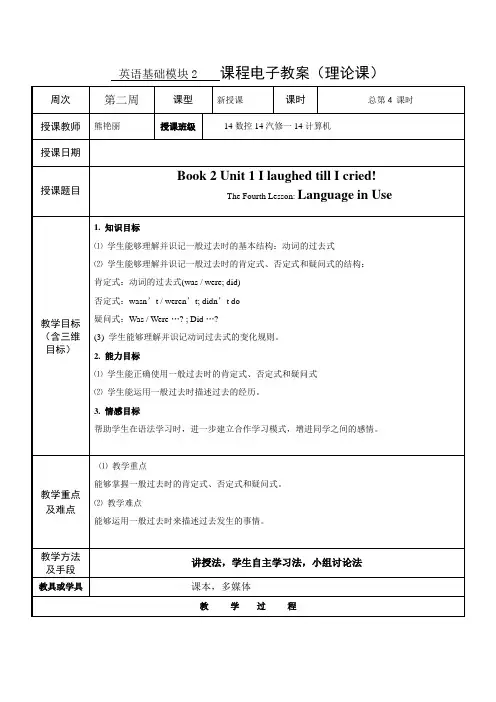
英语基础模块2课程电子教案(理论课)
(设计意图:这一游戏要求学生按照已给的例子,把其他的单词放进正确的信封中。
这里其实在复习动词的过
去式的变化规则。
而采用游戏和竞赛的方式,可以化枯燥为有趣,让学生在玩中学、做中学。
在学生把这些单词全部放入正确的位置后,可以让他们自己来归纳动词过去式的变化规则。
教师还可以在这里让学生
played
studied stopped
went da 一般直接+ed 以不发音e 结尾+d 以辅音字母+y ,则去y 加ied 重读闭音节结尾,双写最后一个字母,然后+ed
(设计意图,找出课文中的关键活动,初步理解课文。
)
3. Activity 12. Read the letters again and tick the correct sentences. Then check the answers with the Ss. See if they have any problems, help them with some important and difficult points.
Li Jie
danced
in the
classroom
last night。
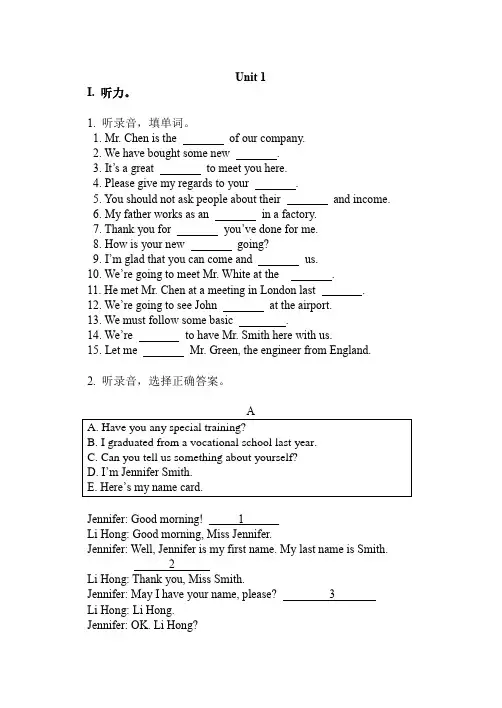
Unit 1I. 听力。
1. 听录音,填单词。
1. Mr. Chen is the of our company.2. We have bought some new .3. It’s a great to meet you here.4. Please give my regards to your .5. You should not ask people about their and income.6. My father works as an in a factory.7. Thank you for you’ve done for me.8. How is your new going?9. I’m glad that you can come and us.10. We’re going to meet Mr. White at the .11. He met Mr. Chen at a meeting in London last .12. We’re going to see John at the airport.13. We must follow some basic .14. We’re to have Mr. Smith here with us.15. Let me Mr. Green, the engineer from England. 2. 听录音,选择正确答案。
Jennifer: Good morning! 1Li Hong: Good morning, Miss Jennifer.Jennifer: Well, Jennifer is my first name. My last name is Smith.2Li Hong: Thank you, Miss Smith.Jennifer: May I have your name, please? 3Li Hong: Li Hong.Jennifer: OK. Li Hong?Li Hong: I’m nineteen and now I’m a bank clerk. But I want to be a secretary.Jennifer: I see. 4Li Hong: Yes, 5Jennifer: That’s fine. Thank you. We’ll let you know our decision later.J : What are you going to do after leaving school?D: I am thinking about becoming a guide. I would like to explore strange things.J : 1D: Of course, I do. 2J : That’s good. You seem to be good at spoken English. Is that right? D: Just so-so. I’ll try to learn it better. 3J : Maybe I’ll be a P.E. teacher. 4D: 53. 听录音,给下面句子排序。
第二册第一单元一、单词1.滑雪v 山n2.海滩n 乘帆航行v3.滑冰v 假期n4.精彩的adj 父亲或母亲n5.出行旅行n 家 ,家庭6.有趣的adj 事业 n7.日常的n 返回 v8.滑到 v 犹豫 n9.典型的 adj 家庭主妇 n10.家庭杂物 n 自愿 v11.火腿 n第二单元一、单词1.电影 n 国际互联网 n2.体育馆 n 卡通片 n3.流行音乐勇敢的 adj4.伶俐的 adj 特别的 adj5.轻松的,放松的 adj. 动人的,感人的 adj6.爵士乐 n 动作电影7.恐怖电影喜剧 n8.脱口秀度过 n9.摇滚乐 n 乐队 n10.乡村音乐租用 v11.订购 v 更喜欢 v12.保持 v二、短语,句子1.你觉得电影咋样?2.在那时3.我邀请朋友一起看电影。
4.我一小时又一小时的坐在电脑前。
5.总是坐在一台机器前是浪费时间的。
6.你上周末做了什么特别的事吗?7.没什么特别的。
8.你以前喜欢什么类型的音乐?9.我曾喜欢爵士乐。
10.你过去喜欢什么类型的电影?11.我曾喜欢动作电影。
12.你通常是怎么过周末的?四.用动词的适当形式填空.cook, stay, say, tell, visit, come, think, take, be, eat1Last Sunday it was snowy. Maria 1 at home. Her cousin Cara 2 tovisit her. She came back from Beijing. She 3 Maria something about her vacation."It was pretty good," she said. Cara 4 the Palace Museum andthe Great Wall. She 5 a lot of photos.It was lunch time. Maria's parents 6 not at home. They decided to cook by themselves. Maria 7 noodles with some tomatoes and pepper (辣椒). After Cara 8 up the noodles, she said slowly, “I think it isdelicious!”But Maria 9 the food was too bad. She 10 ,“Cara, thank you, but I put too much pepper into it.第三单元一、单词1.有创造力的 adj 友好的,直爽的 adj2.自信的 adj 助手 n3.打字员 n 出纳员 n4.幼儿园 n 面试 n&v5.销售,经销 n 毕业 v6.交流 n 流利的 adj7.申请人 n 更有资格;更胜任 v8.张贴 v 广告,公告 n9.简历 n 尽早,尽快10.空闲时间 n 集体自由讨论 v二、短语,句子1.能介绍一下自己吗?2.我在一年公司兼职销售员两年了。
宁德职业技术学院教学过程与内容:Ⅰ. Greeting Ⅱ. PreviewHave a comment on Ss ’ compositions. Pick out some good examples and get the Ss to read them aloud. After reading, ask some questions.(设计意图:教师对于上一课时的学生作文进行讲评,能让学生明确并及时订正自己的差错。
对于优秀作文的肯定及在全班的示范朗读,更能激发学生的自豪感,从而更主动积极地完成作业。
在朗读前,明确任务,听后要回答问题。
这样既能让听的同学更集中注意力,也有意识地培养了大家尊重他人的品质。
) Ⅲ. Lead-inTell the Ss the basic structure of the Past Tense. Ask the Ss if they know the past forms of verbs. Bb: 一般过去时: 动词的过去式(设计意图:在学生作文朗读结束后,教师告诉学生,作文中大家用来描述过去的经历要使用一般过去时。
在之前的听说课和阅读写作课中,学生们实际上已经在运用这一时态。
因此,教师在这里开门见山地提出了本课时要解决的问题。
而问题的提出:什么是动词的过去式?即在下一步骤中马上得到解决。
) Ⅳ. Contents ’ presentation Language in Use1. Game: Get the Ss to put the words into the right envelope.played danced studied stopped went cried came did read returned replied listened watched chatted had enjoyed cooked stayed gave slipped counted asked sent arrived started was were(设计意图:这一游戏要求学生按照已给的例子,把其他的单词放进正确的信封中。
Unit 1We laughed into tears!Part1: 教材分析(Analysis of the teaching material)本课时系教材《英语 2 》(基础模块高教版)第一单元的第一部分,学生听一段关于和家人度假描述的对话。
训练学生在一定的语境下用合适的方式和语句组织关于描述假期活动的对话。
Part2: 教学目标(Teaching aims)Ss can understand expression of vacation description and make a dialogue discussing vacationLead-inAsk the students where did they go and what they did in the summer vacation and winter vacation. (Group discussion and then answer my questions)Step1:Lead students read the phrases and ask Ss to tick the activities they had taken part in.then check the answer.Step2:Teacher show the pictures for the Ss , explain the requests and then play the radio for theSs. Next, teacher asks some students to answer these questions.Listening & SpeakingPart1: 教材分析(Analysis of the teaching material)本课时系教材《英语 2 》(基础模块高教版)第一单元的听力及口语第一部分,学生听一段关于 Cindy 和家人度假描述的对话。